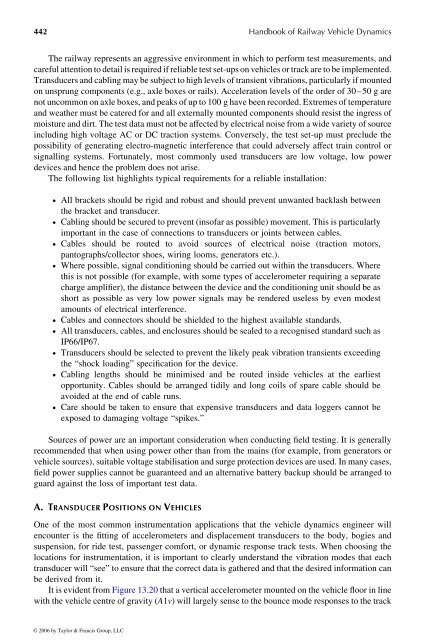Create successful ePaper yourself
Turn your PDF publications into a flip-book with our unique Google optimized e-Paper software.
442<br />
Therailway represents an aggressive environment in which to perform test measurements,and<br />
careful attention to detail is required if reliable test set-ups on vehicles or track are to be implemented.<br />
Transducers and cabling may be subject to high levels <strong>of</strong> transient vibrations,particularly if mounted<br />
on unsprung components(e.g., axle boxes or rails). Acceleration levels <strong>of</strong> the order <strong>of</strong> 30–50gare<br />
not uncommon on axle boxes, and peaks <strong>of</strong> up to 100 ghave been recorded. Extremes <strong>of</strong> temperature<br />
and weathermust be cateredfor and all externally mounted componentsshould resist the ingress <strong>of</strong><br />
moisture and dirt. Thetest data must not be affected by electrical noise from awide variety <strong>of</strong> source<br />
including high voltage AC or DC traction systems. Conversely, the test set-up must preclude the<br />
possibility <strong>of</strong> generating electro-magnetic interference that could adversely affect train control or<br />
signalling systems. Fortunately, most commonly used transducers are low voltage, low power<br />
devices and hence the problem does not arise.<br />
The following list highlights typical requirements for areliable installation:<br />
† All brackets should be rigid and robust and should prevent unwanted backlash between<br />
the bracket and transducer.<br />
† Cabling shouldbesecured to prevent (ins<strong>of</strong>araspossible) movement. This is particularly<br />
important in the case <strong>of</strong> connections to transducers or joints between cables.<br />
† Cables should be routed to avoid sources <strong>of</strong> electrical noise (traction motors,<br />
pantographs/collector shoes, wiring looms, generators etc.).<br />
† Where possible, signal conditioning should be carried out within the transducers. Where<br />
this is not possible (for example, with some types <strong>of</strong> accelerometer requiring aseparate<br />
charge amplifier), the distancebetweenthe device and the conditioning unit should be as<br />
short as possible as very low power signals may be rendered useless by even modest<br />
amounts <strong>of</strong> electrical interference.<br />
† Cables and connectors should be shielded tothe highest available standards.<br />
† All transducers, cables, and enclosures shouldbesealed to arecognised standard such as<br />
IP66/IP67.<br />
† Transducers should be selected to prevent the likely peak vibration transients exceeding<br />
the “shock loading” specification for the device.<br />
† Cabling lengths should be minimised and be routed inside vehicles at the earliest<br />
opportunity. Cables should be arranged tidily and long coils <strong>of</strong> spare cable should be<br />
avoided at the end <strong>of</strong> cable runs.<br />
† Care should be taken toensure that expensive transducers and data loggers cannot be<br />
exposed to damaging voltage “spikes.”<br />
Sources <strong>of</strong> power are an important consideration when conducting field testing. It is generally<br />
recommended that when using power other than from the mains (for example, from generators or<br />
vehicle sources),suitable voltage stabilisation and surge protection devices are used. In manycases,<br />
field power supplies cannot be guaranteed and an alternative battery backup should be arranged to<br />
guard against the loss <strong>of</strong> important test data.<br />
A. T RANSDUCER P OSITIONS ON V EHICLES<br />
<strong>Handbook</strong> <strong>of</strong> <strong>Railway</strong> <strong>Vehicle</strong> <strong>Dynamics</strong><br />
One <strong>of</strong> the most common instrumentation applications that the vehicle dynamics engineer will<br />
encounter is the fitting <strong>of</strong> accelerometers and displacement transducers to the body, bogies and<br />
suspension, for ride test, passenger comfort, or dynamic response track tests. When choosing the<br />
locations for instrumentation, it is important to clearly understand the vibration modes that each<br />
transducer will “see”toensure that the correct data is gathered and that the desired information can<br />
be derived from it.<br />
It is evident from Figure 13.20 that avertical accelerometermounted on the vehicle floor in line<br />
with the vehicle centre <strong>of</strong> gravity(A 1 v )will largely sense to the bounce mode responses to the track<br />
© 2006 by Taylor & Francis Group, LLC









